AMD’s Radeon HD 5850: The Other Shoe Drops
by Ryan Smith on September 30, 2009 12:00 AM EST- Posted in
- GPUs
Power, Temperature, & Noise
With Cypress pared down some for the 5850, the power/temperature/noise situation takes on a different look. The 5870 ended up being hot, noisy, and more power-hungry than any other single-GPU setup under load. Let’s see if the 5850 can avoid that.
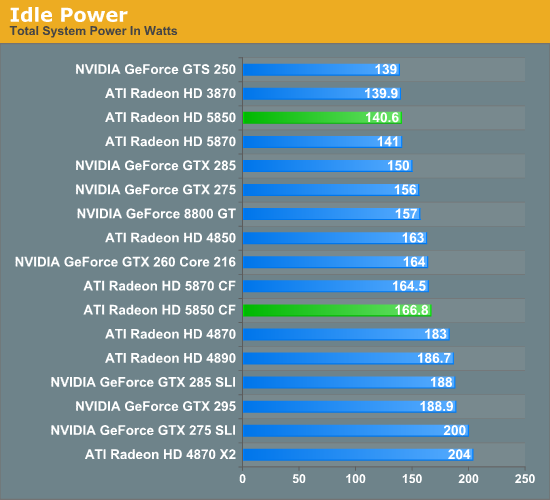
Looking at idle power, the results are the same as the 5870. This is to be expected as both are capable of reaching the same low idle power state. Crossfire results are similar, although the 5850 CF nudges itself higher than the 5870 CF on our charts; but this is within experimental variance.
As was the case with the 5870, the 5850 is among the lowest idling cards we have seen. It’s at the very bottom, only the Radeon HD 3870 and the GeForce GTS 250 can beat it, and even then just by a watt and a half.
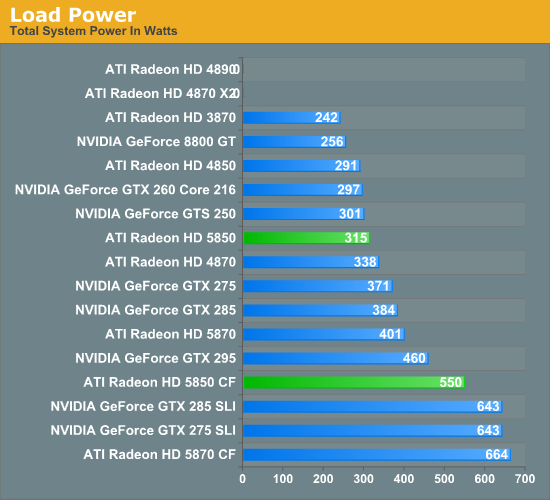
Load power on the other hand gives us a surprising difference. While the 5870 was one of the most power-hungry single-GPU cards we tested, the 5850 moves half-way down the chart. At load it uses less power than 4870 and most of the GTX series, in effect using less power than all of its closest performance competitors. In fact the difference in load power is beyond the specs; AMD’s specs call for a 37W difference, but here we have an 86W difference. Even after accounting for power supply inefficiencies, this is still a huge difference. We’re not seeing clock throttling occurring, so at this point we don’t have a complete explanation for what we’re seeing beyond the fact that we’re sure these are legitimate results.
The end result is that it’s clear that the 5850 is going to work well in systems with limited power abilities. At the same power envelope it’s significantly faster than anything else, and at the same performance level it’s significantly less power hungry than anything else.
As for Crossfire, this gap closes somewhat in that configuration. Here it’s only 114W under the 5870 CF, and just 93W under the GTX SLI cards. Even with its low power usage, the 5850 can’t erase the fact that multi-card solutions eat much more power than single-card solutions; it’s 90W over the GTX295, for example.
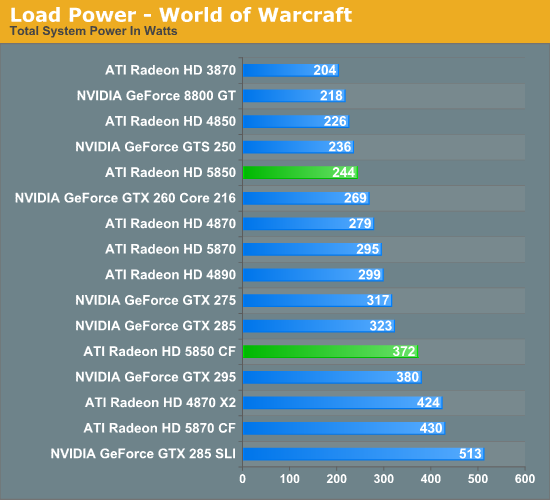
We’ll also take a look at power usage in Warcraft quickly, since it doesn’t trigger throttling in our other AMD cards. Warcraft doesn’t push these cards like OCCT does, so the overall power usage is lower, but the overall situation is virtually the same. The 5850 comes in at 55W less than the 5870, and this time bests the entire GTX lineup by at least 25W. We also see Crossfire do better here; now the 5850 CF can beat even multi-GPU cards like the 4870X2 and the GTX 295.
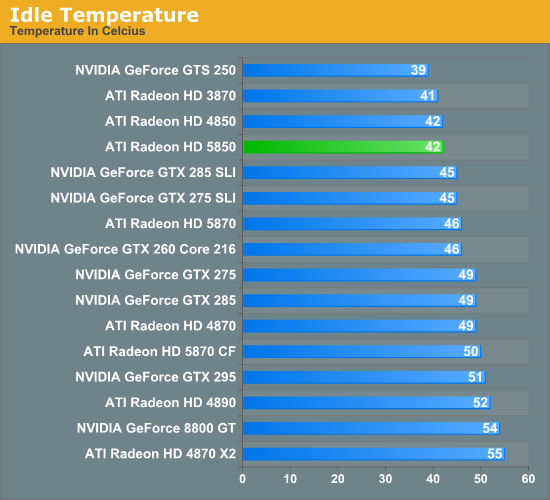
Interestingly enough, in spite of the same idle power as the 5870, the idle temps are not the same. The 5850 comes in at a chilly 42C, bringing it in line with the 4850 and the 3870. Only the GTS 250 can beat it by 3C, and in turn the 5850 beats its closest competitors, the GTX series, by at least 3C.
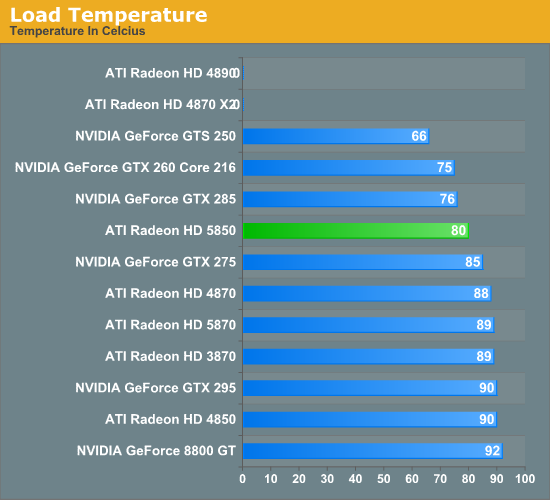
With lower power usage and a similar cooler, the 5850 is capable of keeping cooler than the 5870. While the 5870 approached 90C, the 5850 we’re testing was able to stay at 80C. This makes it the only AMD card we’ve tested that isn’t approaching 90C, which is good news for those of you with limited case ventilation. However it still loses to the GTS 250, and most of the GTX cards. We know NVIDIA is consuming more power, so clearly they have a more effective cooler in use if it’s able to cool their cards that well.
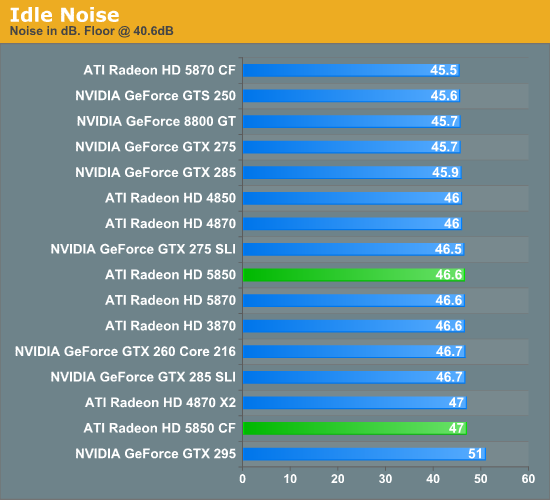
Finally we have noise. At idle virtually everything is the same, the 5850 and the 5870 come in at 46.6dB. To see a significant difference here, we would have to switch to a passively-cooled card.
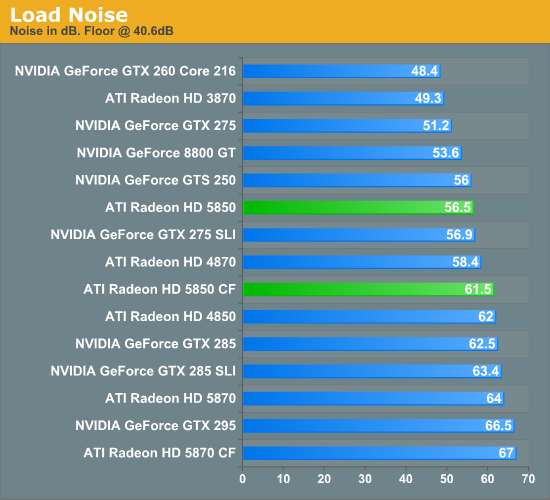
At load, the 5850 is just below the middle of the pack. Thankfully it’s not nearly as loud as the 5870, shaving off 8dB compared to its big brother and brings a Cypress-based card in to more reasonable territory. Adding a second card for Crossfire makes things louder at 61dB, but even that is still 6dB quieter than the 5870 CF.
This also shows us the tradeoffs NVIDIA made in cooling compared to AMD. The GTX 285, which was cooler running, is 6dB louder here as a result. Going by our charts the 5850 is fairly balanced in noise and temperature; it’s doesn’t need to make any trade-offs to achieve one or the other.










95 Comments
View All Comments
Mills - Wednesday, September 30, 2009 - link
AMD's graphics forums and the number of bugfixes and known issues posted for each driver release say otherwise.NVIDIA is not doing so well lately with their drivers either though, especially where Vista/7 is concerned.
Both companies can't seem to get proper fixed aspect ratio GPU scaling working in Vista/7. This has been broken since Forceware 169.04, and my friend tells me broken in a recent Catalyst release. What the hell is going on?
michal1980 - Wednesday, September 30, 2009 - link
I remeber a few years back when Green was on top and Red was dieing. Looks like tables have turned.For the gamer/consumer, IMHO its a win-win.
My new PC next year, just might have an AMD card. I could care less about brand loyality. I buy what ever gives me the most bang for buck at the time I build.
Lavacon - Wednesday, September 30, 2009 - link
I would love to see this card added to the X58 vs P55 GPU article from yesterday. Although I suspect the results would be much the same.vailr - Wednesday, September 30, 2009 - link
Please consider adding a Radeon 4770 card to your comparison chart. I believe it's also "TSMC 40nm".chizow - Wednesday, September 30, 2009 - link
Instead of just marginally reducing performance by dropping clockspeeds and available bandwidth, they artificially neutered their parts by cutting out a few SIMD clusters similar to Nvidia's MO of cutting TPC units.Your conclusion doesn't seem to draw this parallel, that the cut SIMD probably don't factor much into the overall performance because 1580 or whatever is left is enough and the full 1600 aren't being fully utilized in most games today. So instead the 5850 scales more closely to the 15% decrease in clockspeeds compared to the combined 23% for clockspeeds and SIMD units.
The 5870 soft launch followed by today's 5850 paper launch also says quite a bit about 40nm yields in light of their artificial die neutering approach. Reports of AMD shipping *FOUR* 5870 for every *ONE* 5850 for a 4:1 ratio indicates 40nm yields are quite good. Given the high demand and apparently inadquate supply, it makes absolutely no sense whatsoever for AMD to ship these perfectly capable die for a $100 discount when they can sell them for that much more on the 5870.
chrone - Wednesday, September 30, 2009 - link
with beta driver, it can beat nvidia fastest single gpu single card, this card would be an awesome at some moment in the future without breaking the bank for its cost and power consumption.i'm falling in love with this new babe already. :D
Razer2911 - Wednesday, September 30, 2009 - link
I think the current beta drivers are holding the performance of these cards and it can improve by another 10-15%. Maybe ATI is holding it back just in case nVidia brings in some surprise (really doubt it).Strangely the temps mentioned for both the cards are inconsistent with other reviews on the web with Anandtech's being the lowest. Maybe it would be better to post ambient-to-idle/load temps in all your reviews.
LeadSled - Wednesday, September 30, 2009 - link
Nvidia's tech is soon to be so out dated that they will not be a deal at any price. They cannot even do all DX10 spec let alone any DX11 which I do believe ATI has been able to do some DX11 functions since the X1900. I hope Nvidia gets their act together and survives but unlike when 3D was new and Nvidia pushed new tech envolpe they are have been holding progress to a stand still. Nvidia should put up and play the game or get out of the game and make PhysX cards.I do hope they create a 5850X2. These new RV870 gpu's look like they will work well in a 2GB version. Ive heard the 5870X2 will be a 4GB card, lets just hope. I know I would pay $600-$700 for that baby without a thought.
TA152H - Wednesday, September 30, 2009 - link
I am with you, I think NVIDIA needs to go out of business. I think they will.They are at a huge disadvantage without a CPU. Intel is moving CPU/GPU soon, and AMD had this planned for a long time. With Intel already precluding NVIDIA from making chipsets for Nehalem based computers, and ATI making far better GPUs, NVIDIA is running on momentum now, and that runs out over time.
NVIDIA might shirk Intel and make a chipset for Nehalem. While most us wouldn't even consider a crappy NVIDIA chipset, the general market has no idea how problematic they are. They buy from HP and Dell, and they use NVIDIA. I am surprised at how many of these that I see, so it's a good business for NVIDIA.
Right now, the Lynnfield is essentially irrelevant, and the Bloomfield is a niche product. Neither are particularly important products as far as the market is concerned, so NVIDIA isn't really paying a price. Core 2 is still the most attractive platform for mainstream America, or an AMD platform. Clarkdale, with all its flaws, should sell especially well, and even if NVIDIA does decide they want to make a chipset, it won't sell. No one who knows much about computers will buy an NVIDIA chipset, so they sell mainly through HP and Dell, or similar companies. HP and Dell are not going to want to pay extra for an NVIDIA GPU, since the processor comes with one, and really it's only the southbridge that's up for grabs now. This would make a much smaller contribution to their bottom line. It's all bad for them.
Yes, they can sell into the Bloomfield space, if they come up with a good discrete card. But, how big is this market? Lynnfield should be even smaller, being brain-damaged and second-best, but, not particularly cheap like the Clarksdale. Also, it's unlikely someone will want a high priced video card, or two, and pair it with anything but the best platform.
So, where does NVIDIA sell into? Core 2 will go away, Bloomfield and Lynnfield will have relatively small market shares, and Clarksdale should sell especially well in the markets where NVIDIA chipsets sell well now.
Anand said the Clarksdale was the replacement for the Conroe, which caught a lot of FlAK, because he worded it poorly. But, in a way, he's right with respect to the Clarksdale replacing the Core 2 as the platform for the mainstream market. In this respect, the Clarksdale is better in almost all respects. It's dual core, but runs four threads. Sure, they put the MMU in the wrong place, but it's still better than being outside the processor, and the GPU is better than the G45. On top of this, it should be cheaper. Core 2 duals, with Pentiums, etc..., sell the best, still. Clarksdale is better, and should be cheaper, so it's going to dominate the market in the same way. Bloomfield is king of performance, and will have a place. It's not a big one though. Lynnfield is a good combination of power and decent performance. It's also not a big space, although the i5 750 might do well and shouldn't be discounted. The big space will be the Clarksdale. NVIDIA is going to be hurt by it. Hopefully, fatally.
Pastuch - Monday, October 5, 2009 - link
I disagree with you on ALL points. I buy 2 videocards per year and I own an almost equal number of ATI/Nvidia cards. I just bought a 4890 and next will be a 5850.Nvidia should definitely NOT go out of business. Competition drives creativity and reduces prices for consumers. I would hardly say Nvidia is doing badly at the moment. The bulk of aftermarket videocards still come from Nvidia. They are still ahead of ATI in marketshare. They are also a marketing juggernaught; "The Way its Meant to be Played" is a very powerful marketing tool. That being said I expect a firm advantage for ATI over the next six months.
I have owned several Nvidia chipset motherboards and they have all been exceptionally reliable and great overclockers. I've never had driver issues with them. I find Clarksdale underwhelming. G45 didn't live up to all its promises (Bitstreaming) and I seriously doubt that it's successor will either. G45 has the least features and customizability of any onboard solution I have used yet. Intel has a long way to go on integrated video if they ever want to capture the enthusiast market.
ATI has been doing a stellar job lately. The 5850 is every hometheater guys dream. Inexpensive, Bitstreaming HD content and it will fit in most HTPC cases. The latest GTX cards and the 5870 are too long. Videocards should be less than 10 inches long!